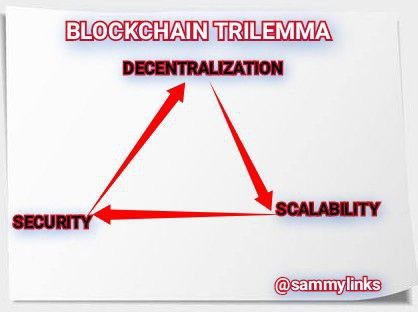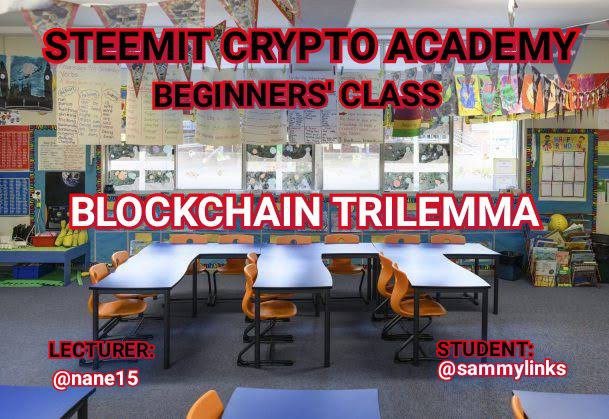Blockchain Trilemma - Crypto Academy / S5W2 - Homework post for nane15
Hello everyone,
I'm very happy to participate in this week's lecture mentored by our crypto-professor @nane15 which focused on "BLOCKCHAIN TRILEMMA" AND HOW IT WAS SOLVED SUCCESSFULLY
In this post, the homework tasks given as stated below will be structured as paragraphs:
EXPLAIN IN YOUR OWN WORDS, WHAT THE BLOCKCHAIN TRILEMMA IS
IS BLOCKCHAIN TRILEMMA REALLY A TRILEMMA
DEFINE THE FOLLOWING CONCEPTS IN YOUR OWN WORDS:
DECENTRALIZATION
SCALABILITY
BLOCKCHAIN SECURITYBASED ON YOUR EXPERIENCE, EXPLAIN AT LEAST. TWO VIABLE SOLUTIONS TO THE CHALLENGES POSED BY BLOCKCHAIN TRILEMMA
CONCLUSION

EXPLAIN IN YOUR OWN WORDS, WHAT THE BLOCKCHAIN TRILEMMA IS
The term BLOCKCHAIN TRILEMMA was coined by Vitalik Buterin as a serious challenge that Blockchain networks faced as they want to be decentralized, scalable and secured without compromising any of these three vital facets of any great Blockchain networks.
Blockchain networks should be decentralized in nature but this decentralized system of Blockchain ecosystem have challenges that limits their operations when compared to the Centralized Platforms which is very scalable and secured in their handling huge Volumes of transaction per second. As the decentralized system of Blockchain technology have a great capacity of storing data which will consistent, available at all times, immutable after verified consensually etc but there's a fear that in this networks, their verified data can't be secure, handle huge transaction per second (i.e, scalability) and still be decentralized system at once.
A Centralized Platforms like VISA etc have a central authority that oversee their operations thereby facilitating their services within a highly secured system which Blockchain networks depends on their consensus mechanism whereby several node have to agree before the execution of transactions orders in a very transparent mode in order to boast the reliability of those widely ranged nodes but exposed to frequent security attacks Which is a very big challenge. For instance, Bitcoin, first successful Blockchain network solve a lot of challenges of those predecessors like double -spending etc to become very secure and decentralized platforms but as the transaction within the networks keep increasing beyond its capacity of handling seven transactions per second that's become a challenge. Developers of other subsequent blockchain networks keep trying their best to improve their networks in the areas of security, scalable and decentralized networks.

IS BLOCKCHAIN TRILEMMA REALLY A TRILEMMA

The word "TRILEMMA" stand for a situation whereby out of three options, one can't get it all. One or two of three options must be compromised while achieving one or two of the three options efficiently. In the public blockchain networks, it is of note that developers are ever busy to design a blockchain networks that will be decentralized, secure and scalable without compromising any of these vital attributes.
For instance, EOS and Solana are blockchain networks have a great scalable prowess that handles huge volumes of transaction per second. In EOS, The current system can handles 4,000 transactions per second while Solana network handles over 40,000 transactions per second at it's peak which are very great and their Whitepapers suggests more scalability prowess that can rivals VISA, a centralized Platforms of over 60, 000 transactions per second. But these Blockchain networks, EOS and Solana Blockchain, are they purely decentralized networks? Are they fully secured to be protected against any Security breaches? Will they be able to continue handling these huge volumes of transaction per second or more? Their developers are still working harder to answer these questions convincingly.

DEFINE THE FOLLOWING CONCEPTS IN YOUR OWN WORDS:
DECENTRALIZATION
SCALABILITY
BLOCKCHAIN SECURITY
DECENTRALIZATION
The term Decentralization stand for a situation where there's no central authority or body that control the operations of the organization. In Blockchain networks, there's no central authority that oversee their operations. Coins can be stored and transacts freely without intermediaries. Every transaction fully executed and verified are duly recorded in the Blockchain technology which is a Cryptographic ledger as blocks of verified transaction data. These blocks of verified transaction data can be transparent and trackable but can be mutated or erased by any known means. For a block of these transactions to be verified and validated, a consensus or agreement must be reached by the widely ranged nodes via any adopted mechanisms. The operations of these nodes depicts the Blockchain technology as a decentralized platforms as these nodes are independent and works separately but their activities are linked together to form a comprehensive, secured and responsive networks.
Here, in Decentralization nature of blockchain networks, transaction are mainly Peer to Peer modal in which several nodes can carry out transactions without third parties or intermediaries. Decentralization improve privacy as there's virtually no needs for those several nodes' identities unlike Centralized Platforms where there's a requirement for kyc verification process before using their services which limit privacy and promotes governmental interference.
SCALABILITY
The rate at which the transactions can be executed and validated per second can be referred as scalability. Due to the nature of validation of transaction orders and recorded verified orders in a single long chain, these always results to a slow or delay functions inherent in blockchain networks. Reasons for a rigorous validation process of blockchain networks enhances it's Security and prevent the chances of double - spending.
However, from second to fifth generations of blockchain networks have improves the scalability prowess of their networks with modernized approaches. These approaches increase the rate/number of transactions executed effectively when measured within seconds. The examples of EOS and Solana Blockchain networks mentioned above shows the level of improvement on the scalable abilities of recent blockchain networks.
BLOCKCHAIN SECURITY
The technological advancement of blockchain technology over the human endeavors are marvelous especially in the financial sectors. To increase the reliability of clients on financial services, they should know that their assets and funds are secured and readily available whenever they requested for them.
There have been some security challenges including 51% attacks etc over blockchain networks and assets therein but developers keep working harder to debugged and protected their system. Mostly blockchain networks are embedded into the world of cryptography. The Cryptographic functions and technical abilities protects the various aspects of blockchain technology. With those forms of Cryptographic functions and other enhanced abilities, the transaction can be transparent, trackable and highly secured too.

BASED ON YOUR EXPERIENCE, EXPLAIN AT LEAST. TWO VIABLE SOLUTIONS TO THE CHALLENGES POSED BY BLOCKCHAIN TRILEMMA
There's an enhanced approaches to solve the challenges presented by blockchain trilemma. Let's focus on the challenges of scalability.
The problems of Scalability hampers the growth of blockchain ecosystem and have been solved in these TWO broad methods.
- LEVEL -1 PROTOCOLS
- LEVEL - 2 PROTOCOLS
LEVEL -1 PROTOCOLS
In level - 1 Protocols, the developer focused mainly on improving the consensus mechanisms adopted by the Blockchain networks especially that of Bitcoin, Ethereum and Litecoin.
In Bitcoin and Litecoin, the consensus mechanisms adopted to validate the transaction needed to be improved in order to enhance the scalability prowess of those networks. Their consensus mechanism is POW Which is Proof Of Work. In POW, any node that wants to validate a block of data MUST solve a cryptographic puzzles with high computational power and gadgets of huge electric power consumption and high maintenance. The ability to solves the puzzles and other expenses incurred proved a work by the node validates the block of transaction data and a reward (i.e, a minted Coin of the networks maybe Bitcoin or Litecoin) derived by the node from the process. This rigorous validation process slow down the rate of Scalability and accounts to seven transactions per second. But there's a Scalability improvement in the Ethereum 2.0 due to its adopted consensus mechanism. In Ethereum 2.0 networks, the consensus mechanism is termed POS where nodes known as miners in Bitcoin are called Validator because they are nominated to validate a block of transaction data based on the amount of staked-weight acquired. The node with highest staked validate and verified the block and get rewards. Each nodes that wants to be a Validators must locked a percentage of the coin/token(i.e, ether for Ethereum blockchain) to be nominated to validates the blocks of transaction data. With this consensus mechanism of Ethereum blockchain, their networks because more scalable, secured and vital Platform for smart contracts and other projects/Protocols.
In Level 1 Protocols, there's another method called Sharding. In this approach, the huge volumes of transactions are breaking into smaller-set data called shard and handles across the nodes so as to enhance the rate of it's Scalability. Those shards still maintain their details from the mainchain, even as they are undergoing processing in different nodes which are linked together. Their unique details which is still consistent with one another is the same addresses, timestamps, balances and other details. With this procedure, the scalability prowess are enhanced and can be seen in Ethereum 2.0 Blockchain, Zilliqa, Tezos, Qtum etc
LEVEL - 2 PROTOCOLS
As the name implies, Level-2 protocols are applied on the Blockchain networks and technology to enhance it's scalability and security.
For Bitcoin, Litecoin, and other POW networks, a lighting networks are embedded and enhanced to improve the transaction speed of those networks. There are several forms of lighting networks and more improvements are evolving too to increase the transaction speed and solves the scalability challenges more.
In Ethereum, other networks, Nested networks are applied. A good example of nested networks applied as a Level-2 protocols over Ethereum blockchain is called OMG PLASMA to enhance the rate of scalability and security. With this, there's a effective distribution of validation processes among the nodes that reduces excessive burdens on the mainchain thereby promoting the scalability. This approach increase the transaction speed and make it cheaper too.

CONCLUSION
However, the concept of Blockchain Trilemma is still a model that developers are adopting to enhance their networks and solving or not solving these challenges presented by this concept does not affect the operations of the existing networks badly. Some of these networks are striving harder to improve any of these three vital components of a great blockchain networks of being decentralized, secure and very scalable.
